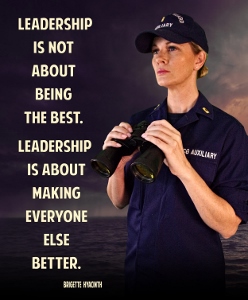Return to AUX60 C-School's Home Page.
NEXCOM, ANACO, DCO
Fundamental to successful development as a leader is an understanding of self and one’s own abilities. This includes understanding one’s personality, values, and preferences, while simultaneously recognizing one’s potential as a member of the Coast Guard team. Personal conduct, health and well-being, character, technical proficiency, lifelong learning, followership, and organizational commitment are elements to consider when setting short and long-term goals focused upon the leadership development of “self.”
Leadership involves working with and influencing others to achieve common goals and to foster a positive workplace climate. Auxiliarists interact with others in many ways, whether as supervisor, mentor, manager, team member, team leader, peer or worker. Positive professional relationships provide a foundation for the success of our Service. Showing respect for others, using effective communications, influencing others, working in teams, and taking care of one’s people are elements to consider when evaluating one’s capacity for leading others. Developing these qualities will increase capacity to serve.
Members of the Coast Guard team constantly face challenges in mission operations. To meet these challenges, leaders must apply performance competencies to their daily duties. Performance competencies include developing a vision, managing conflict, quality and daily management of projects, appraising performance, problem solving, creativity, innovation, decision making, and customer focus. Having these competencies enables each leader—and the Service—to perform to the utmost in any situation.
As leaders gain experience in the Coast Guard Auxiliary, they must understand how it fits into a broader structure of the Coast Guard, government, and the nation as a whole. At a local level, leaders often develop partnerships with public and private sector organizations in order to accomplish the mission. The Coast Guard "plugs in" via its key systems: money, people, and technology and the Auxiliary supports Coast Guard activities. A leader must thoroughly understand these systems and how they interact with similar systems outside the Coast Guard. An awareness of the Coast Guard's value to the nation, and promoting that using a deep understanding of the political system in which an Auxiliarist operates becomes more important as one gets more senior. Leaders must develop coalitions and partnerships with allies inside and outside the Auxiliary.
Methods for Gaining and Demonstrating Competence
Auxiliarists are a diverse group. Some have extensive civilian leadership training and experience. Others have had more limited opportunities. To ensure success the Auxiliary needs capable leaders at all levels in the organization. The above sections define the minimum expectations for leaders at each level in the Auxiliary. This section identifies the intended performance level targets for each of the major Auxiliary leadership training courses.
In addition to Auxiliary training courses, there are other resources available to Auxiliarists. Check with your Member Training Staff Officer for available sources.
Many Districts publish District Policy Manuals. Auxiliary members at all levels are encouraged to utilize these resources.
The section below describes the specific leadership/management courses intended for each level and the minimum performance level targets for each of these in terms of the 28 leadership competencies expected of graduates of these courses. Three target performance levels are included:
1. Awareness: The Auxiliarist is aware of the concept and can define its meaning.
2. Application: The Auxiliarist is capable of applying the concepts and principles of the leadership competency in his/her customary work environment (e.g., at the Flotilla, Division, District, or National Levels).
3. Overall responsibility: The Auxiliarist has awareness, application skills, and overall responsibility for ensuring that members in their care have sufficient training and skills.
In the descriptions below, these three levels (awareness, application, overall responsibility) are denoted 1, 2, and 3 respectively.
Level Five (NEXCOM, ANACO, DCO)
Level five leaders have should have had the opportunity to complete the Basic Qualification Course (BQC) and (in many cases) the Auxiliary Procedures Course (APC), the Auxiliary Leadership and Management School (AUXLAMS), the Flotilla Commanders Academy (FCA), the Auxiliary Mid-Level Officer Course (AMLOC), and the Auxiliary Upper Level Officer Course (AULOC).
The Auxiliary Senior Officer Course (ASOC) is actually designed to prepare members to transition to level five, to the positions of District Chief of Staff or Assistant National Commodore. ASOC emphasizes “3s” in most of the competencies it teaches. ANACOs and DCOs who complete this course are expected to master competencies in all four categories.
Follow-up on additional competencies is done with the level five leaders through workshops and independent study projects relative to their positions.
